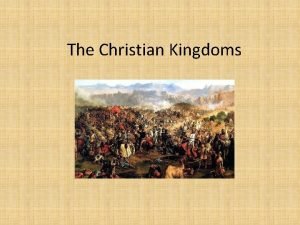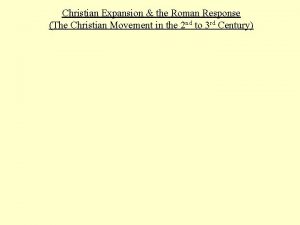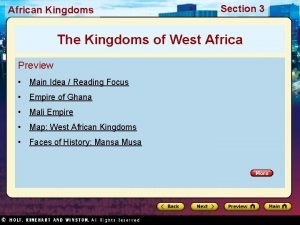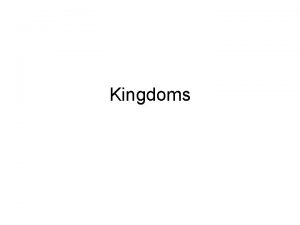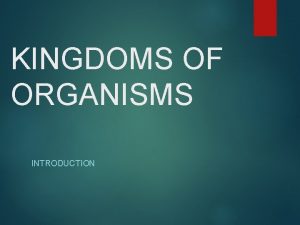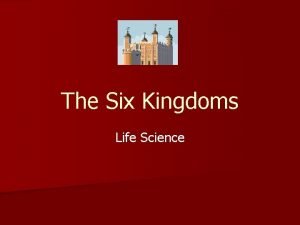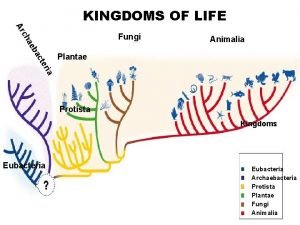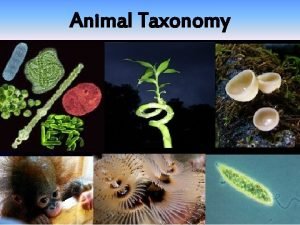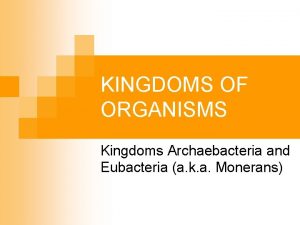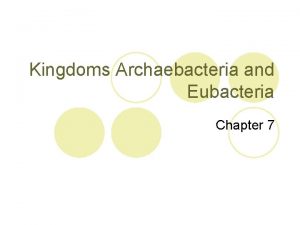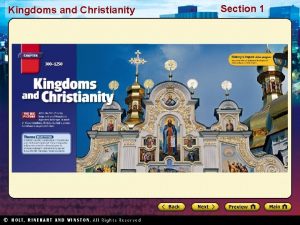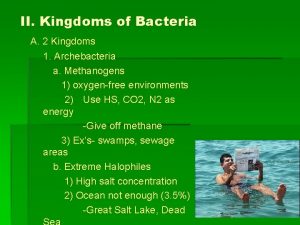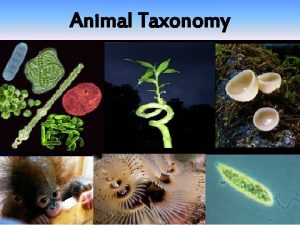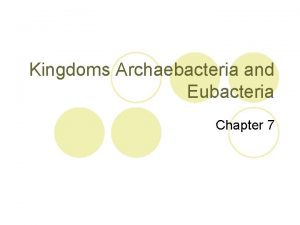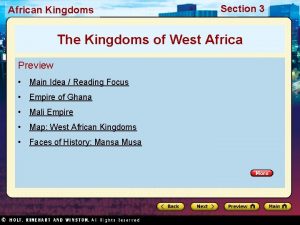The Christian Kingdoms EXPANSION OF THE CHRISTIAN KINGDOMS



















- Slides: 19

The Christian Kingdoms

EXPANSION OF THE CHRISTIAN KINGDOMS

EXPANSION OF CHRISTIAN KINGDOMS Book page 60 • The Reconquista involved the occupation of territory from one river valley to another • In 9 th and 10 th centuries christian kingdoms advanced south of the Duero valley. It wasn´t a conquest. This territory was abandoned by the muslims • In 11 th and 12 th centuries, christian kingdoms extended beyond the Tajo valley and the Ebro valley (Conquest of Toledo by Alfonso VI in 1085 and conquest of Zaragoza by Alfonso I the Battler in 1118) • After the battle of Las Navas de Tolosa (1212), christian kingdoms advanced quickly and extended beyond the Guadiana and Guadalquivir valleys http: //www. youtube. com/watch? v=IHKev 1 M 140 o • At the end of 13 th century only the Nasrid kingdom of Granada resisted the christian forces.

EXPANSION OF CHRISTIAN KINGDOMS • After the occupation of the new territories, the christian kings colonised them with groups of peasants. This is called Repopulation • In order to encourage emigration, the kings gave privileges called fueros to the towns • Sometimes the territory was underpopulated, so the kings gave it to the military orders

FUERO (CARTA PUEBLA) OF CIUDAD REAL GIVEN BY ALFONSO X é quis que oviera hy una grand villa é bona que corrieresn todos por fuero é que fuese cabesza de toda aquella tierra é mandela poblar en aquel lugar que dicen el Pozuelo de D. Gil, é púsele nombre Real. Et Yo sobre dicho Rey D. Alfonso otórgoles é doles para siempre jamás é á todos los moradores que fuesen en esta Villa-Real la sobre dicha é en todo su término que hayan el fuero de Cuenca en todas cosas

THREE CULTURES • DURING THE RECONQUISTA THREE DIFFERENT RELIGIOUS CULTURES LIVED TOGETHER IN THE CHRISTIAN KINGDOMS: • CHRISTIANS, • JEWS, SOMETIMES PERSECUTED AND • MUSLIMS, CALLED MUDÉJARES

Kingdom of Asturias and León • 722. Battle of Covadonga. Don Pelayo defeated the Muslims • At the End of VIII century, Alfonso II established the court in Oviedo • Alfonso III the Great expanded the Kingdom and moved the capital to León in the 10 th century. The territory became the Kingdom of León

Kingdom of Castile • Castile started as a union of some counties from León under Fernan González that became Count of Castile in 930 and could achieve a relative independence from León in 960 • After being annexed to Navarra, it became an independent Kingdom after the death of Sancho III de Navarra in 1035. The first King of Castile was Fernando I Tomb of Fernán González en Covarrubias

The Kingdom of Navarra • During IX century, the Jimena dinasty could achieve independence from the carolingian Empire • Under Sancho III the Great (1000 -1035) the Kingdom of Navarra became the most powerful kingdom in the Peninsula • After his death, his kingdom was divided between his sons: Fernado became king of Castile, García became king of Navarra and Ramiro became king of Aragón

The Kingdom of Aragón • During IX century the Galindo family achieved independence from the Carolingian Empire with the count Aznar Galindo. • In 922 the county of Aragón was annexed to Navarra • After the death of Sancho III the Great of Navarra (1035), his son Ramiro I became the firs King of Aragón

The Catalan Counties • In 874, Wilfred the Hairy united the catalan counties and became independent from the carolingians The Kingdom of Portugal In 1143, Alfonso Enríquez became independent from the Kingdom of León and was the first King of Portugal

The Crown of Castile • After Fernando I became the first King of Castile, Castile gradually became the most powerful Kingdom. Alfonso VI conquered Toledo in 1085 and passed the Tajo valley. • Alfonso VIII defeated the almohads in the Battle of Las Navas de Tolosa in 1212 • In 1230 Fernando III the Saint united León and Castile and founded the Crown of Castile

The Crown of Castile (II) • Government Castile and León became a unified State, with same institutions and same law The King had great power and the castilian Parliament, called Cortes, could not legislate, but just approve or reject new taxes • Economy Based on agriculture, but mainly stockbreeding of merino sheep. The wool of the merino sheep was exported to Europe and was economically so important that the kings protected its trade and granted privileges to the Mesta (assembly of noble sheep breeders) as the right to graze on peasants´ land.

The Crown of Aragón • In 1134 died Alfonso I the Battler without issue • His brother, Ramiro II, who was a monk, was forced to become King and to have a child • Ramiro II, had a daughter, Petronila, who was betrothed to Ramon Berenguer IV, count of Barcelona, at the age of one. After the marriage, they had a son, called Alfonso Ramon, who became King of Aragón and Count of Barcelona as Alfonso II the Chaste. This union is called the Crown of Aragón • In 13 th century, James I the Conqueror expanded the Crown of Aragón to the south conquering Valencia, Alicante, Murcia and the Balearic islands. His son, Peter the Great conquered Sicily and started the expansion through the Mediterranean Sea

The almogavars • The almogavars were professionals soldiers, who served the kings of Aragón with their Mediterranean expansion. After conquering Sicily, Sardinia and Naples, the Kings of Aragón wanted to get rid of such violent troops and let them travel to help the Byzantinian Emperor against the muslims. After fighting the turks, they were betrayed by the byzantinians and their leader, Roger de Flor, was assassinated. The almogavars, in revenge, conquered Athens and its territory and established there the duchies of Athens and Neopatria. Although the duchy eventually fell to the Ottoman Empire, even today the King of Spain still holds the title of 'Duke of Athens and Neopatria'.

The almogavars Entry of Roger de Flor in Constantinople Painting of José Moreno (1888)

The Crown of Aragón (II) • Government The Crown of Aragón was a union of different kingdoms (Aragón, Valencia, Mallorca) and counties (catalan counties). Each territory kept its own institutions and customs: Justicia in Aragón, Generalitat in Catalonia and Valencia. The Kings of Aragón had always to seek their approval for starting new enterprises • Economy Agriculture was the main economic activity in Aragón Trade was very important too. After the mediterranean expansion of the Crown of Aragón, the catalan merchants travelled all around de Mediterranean Sea and founded commercial offices called Consulates

Compare the Crowns of Castile and Aragón GOVERNMENT CROWN OF CASTILE CROWN OF ARAGÓN UNIFIED STATES SAME INSTITUTIONS, SAME LAW FOR ALL THE KINGDOM CORTES HAD NO POWER ECONOMY AGRICULTURE BUT MAINLY STOCK BREEDING OF MERINO SHEEP UNION OF DIFFERENT MAINLY AGRICULTURE AND KINGDOMS WITH THEIR TRADE OWN LAWS AND CUSTOMS THE KINGS HAD TO SEEK THE CORTES´APPROVAL

VIII ASTURIAS DON PELAYO 722: COVADONGA LEÓN IX X XI ALFONSO III ESTABLISH THE COURT IN LEÓN 929: COUNT FERNÁN GONZÁLEZ CASTILE JIMENA DINASTY NAVARRE GALINDO DINASTY AZNAR GALINDO ARAGÓN XII SANCHO II KING OF NAVARRE AND ARAGÓN GARCÍA RAMIRO I WILFRED THE HAIRY CATALONIA 1230: FERNANDO III THE SAINT, CROWN OF CASTILE FERNANDO I ALFONSO VI SANCHO III THE GREAT (10001035) ALFONSO II THE CHASTE CROWN OF ARAGÓN 1143: ALFONSO ENRIQUEZ, KINGDOM OF PORTUGAL ALANDALUS DEPENDENT AND INDEPENDENT EMIRATE 929: ABD AL RAMAN III CALIPHATE OF CORDOBA XIII 1032: TAIFAS 1086: ALMORAVIDS ALMOHADS JAMES I
 Christian kingdoms
Christian kingdoms Từ ngữ thể hiện lòng nhân hậu
Từ ngữ thể hiện lòng nhân hậu Trời xanh đây là của chúng ta thể thơ
Trời xanh đây là của chúng ta thể thơ Tư thế ngồi viết
Tư thế ngồi viết Voi kéo gỗ như thế nào
Voi kéo gỗ như thế nào V. c c
V. c c Thể thơ truyền thống
Thể thơ truyền thống Hổ đẻ mỗi lứa mấy con
Hổ đẻ mỗi lứa mấy con đại từ thay thế
đại từ thay thế Thế nào là hệ số cao nhất
Thế nào là hệ số cao nhất Diễn thế sinh thái là
Diễn thế sinh thái là Vẽ hình chiếu vuông góc của vật thể sau
Vẽ hình chiếu vuông góc của vật thể sau Ng-html
Ng-html Thế nào là mạng điện lắp đặt kiểu nổi
Thế nào là mạng điện lắp đặt kiểu nổi Mật thư anh em như thể tay chân
Mật thư anh em như thể tay chân Lời thề hippocrates
Lời thề hippocrates Tư thế worms-breton
Tư thế worms-breton Vẽ hình chiếu đứng bằng cạnh của vật thể
Vẽ hình chiếu đứng bằng cạnh của vật thể Quá trình desamine hóa có thể tạo ra
Quá trình desamine hóa có thể tạo ra Sự nuôi và dạy con của hổ
Sự nuôi và dạy con của hổ
